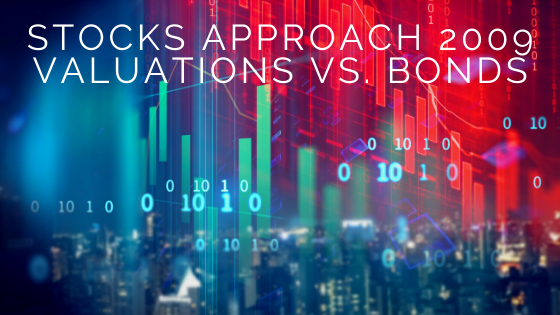
Stocks Approach 2009 Valuations vs. Bonds
We rolled out our Road to Recovery Playbook at the start of the week to help investors gauge where the market is in its bottoming process. The first and most important piece of that playbook—visibility into a peak in new COVID-19 cases—remains elusive, but we hope to have a clearer picture with the next couple of weeks as containment efforts have more time to work. We continue to monitor cases daily and plan to update you on that progress regularly during this crisis.
We’re getting closer to checking off the other four boxes. We would just like to see a bit more economic data consistent with recession—almost surely coming soon—and to get more clarity on the timing, size, and nature of the policy response before checking off those two boxes on our list. The technical analysis and sentiment box was checked last week—the amount of bearishness among investors is near the levels of prior bear market lows.
The last box—markets pricing in recession—was also checked last week based on the magnitude of the sell-off. The nearly 30% drop in the S&P 500 Index from the February 19 high is close to the average peak-to-trough decline in recessions at about 35%.
Another way to show a recession is priced in and stocks may be near their ultimate bottom is by valuing stocks relative to bonds, sometimes called the equity risk premium (ERP), which we show in the LPL Chart of the Day.
“Stocks are now historically cheap by most measures after this selloff,” noted LPL Chief Investment Officer Burt White. “When comparing stock valuations to bond yields, we are approaching levels only seen during some of the worst bear markets over the past 50 years.”
The equity risk premium compares the earnings yield on the S&P 500 (the inverse of the price-to-earnings ratio) to the 10-year US Treasury yield. That number as of March 18 was 4.9%, well above the long-term average of 0.8% (it was higher on March 16 when the 10-year Treasury yield was 0.73% rather than 1.18%). That compares to historical peaks between 6 and 7% in 1974 and shortly after the financial crisis.
The bottom line is that if this trend holds equity investors could be well compensated over time for the risks they are taking now.

We know it’s tough to see the other side of this crisis right now, and the volatility is unnerving for all of us. But historically, investors who owned stocks at these valuations have been rewarded over time. We think this time will be no different.
IMPORTANT DISCLOSURES
This material is for general information only and is not intended to provide specific advice or recommendations for any individual. There is no assurance that the views or strategies discussed are suitable for all investors or will yield positive outcomes. Investing involves risks including possible loss of principal. Any economic forecasts set forth may not develop as predicted and are subject to change.
References to markets, asset classes, and sectors are generally regarding the corresponding market index. Indexes are unmanaged statistical composites and cannot be invested into directly. Index performance is not indicative of the performance of any investment and do not reflect fees, expenses, or sales charges. All performance referenced is historical and is no guarantee of future results.
Any company names noted herein are for educational purposes only and not an indication of trading intent or a solicitation of their products or services. LPL Financial doesn’t provide research on individual equities. All information is believed to be from reliable sources; however, LPL Financial makes no representation as to its completeness or accuracy.
This Research material was prepared by LPL Financial, LLC.
Securities and advisory services offered through LPL Financial (LPL), a registered investment advisor and broker-dealer (member FINRA/SIPC).
Insurance products are offered through LPL or its licensed affiliates. To the extent you are receiving investment advice from a separately registered independent investment advisor that is not an LPL affiliate, please note LPL makes no representation with respect to such entity.
If your representative is located at a bank or credit union, please note that the bank/credit union is not registered as a broker-dealer or investment advisor. Registered representatives of LPL may also be employees of the bank/credit union.
These products and services are being offered through LPL or its affiliates, which are separate entities from, and not affiliates of, the bank/credit union. Securities and insurance offered through LPL or its affiliates are:
- Not Insured by FDIC/NCUA or Any Other Government Agency
- Not Bank/Credit Union Guaranteed
- Not Bank/Credit Union Deposits or Obligations
- May Lose Value
For Public Use | Tracking # 1-968334